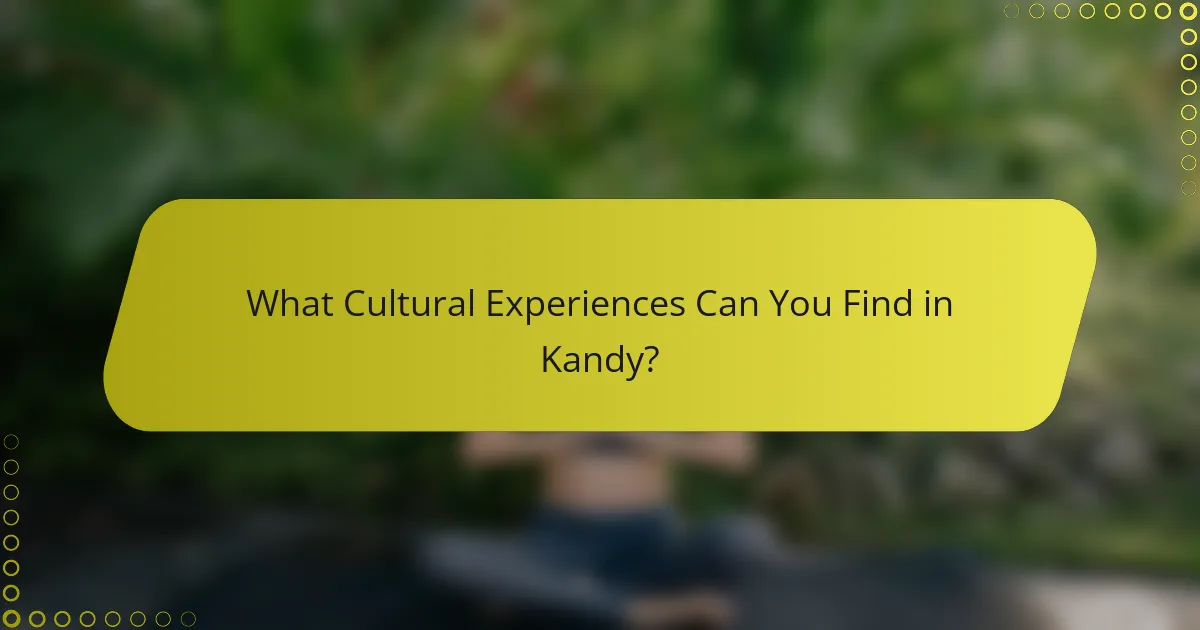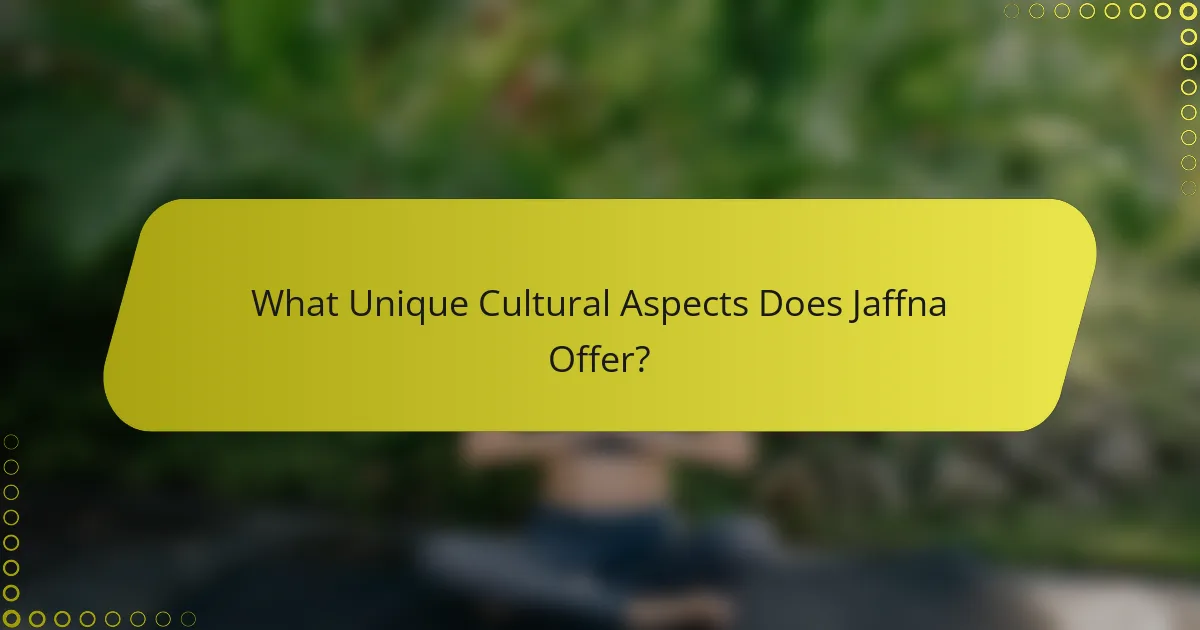Discover the vibrant cultural landscapes of Sri Lanka through its diverse cities: Kandy, Colombo, Jaffna, Galle, and Negombo. Each destination offers a unique blend of history, traditions, and local experiences, inviting visitors to engage with the rich heritage and lively festivals that define the island’s identity. From Kandy’s sacred sites to Colombo’s bustling arts scene, immerse yourself in the cultural tapestry that makes Sri Lanka truly captivating.

What Cultural Experiences Can You Find in Kandy?
Kandy offers a rich tapestry of cultural experiences that reflect Sri Lanka’s heritage. Visitors can immerse themselves in religious sites, vibrant festivals, and traditional arts, making Kandy a focal point for cultural exploration.
Temple of the Tooth Relic
The Temple of the Tooth Relic, or Sri Dalada Maligawa, is one of the most sacred Buddhist sites in the world. It houses a tooth relic of the Buddha, drawing pilgrims and tourists alike. Visitors can explore the temple complex, which features stunning architecture and intricate decorations.
When visiting, dress modestly and be prepared for security checks. Guided tours are available, providing insights into the temple’s history and significance.
Kandy Esala Perahera Festival
The Kandy Esala Perahera is a spectacular annual festival held in July or August, celebrating the Tooth Relic. This grand procession features traditional dancers, drummers, and beautifully adorned elephants, creating a vibrant atmosphere.
To experience the festival fully, plan to book accommodations well in advance, as Kandy becomes quite crowded. Arriving early for the best viewing spots along the parade route is advisable.
Botanical Gardens
The Royal Botanical Gardens in Peradeniya, just outside Kandy, showcase a diverse collection of flora. Spanning over 60 hectares, the gardens feature thousands of plant species, including orchids and palm trees.
Visitors can stroll through well-maintained pathways and enjoy the serene environment. Guided tours are available, which can enhance your understanding of the various plants and their uses in local culture.
Cultural Dance Performances
Kandy is renowned for its traditional Kandyan dance performances, which are an integral part of Sri Lankan culture. These dances often depict historical events and religious rituals, characterized by vibrant costumes and rhythmic drumming.
Check local listings for scheduled performances at venues like the Kandy Cultural Centre. Attending a show can provide a deeper appreciation of the region’s artistic heritage.
Local Cuisine Experiences
Kandy’s local cuisine offers a delightful array of flavors, heavily influenced by Sri Lankan spices and ingredients. Dishes such as rice and curry, hoppers, and kottu roti are must-tries for any visitor.
For an authentic experience, consider dining at local eateries or participating in a cooking class. This hands-on approach allows you to learn about the ingredients and techniques used in traditional Sri Lankan cooking.

How to Explore Colombo’s Cultural Scene?
To explore Colombo’s cultural scene, focus on its rich history, vibrant arts, and diverse culinary offerings. Engage with museums, historical sites, and local food tours to gain a deeper understanding of the city’s heritage.
National Museum of Colombo
The National Museum of Colombo is the largest museum in Sri Lanka, showcasing a vast collection of artifacts that reflect the country’s history and culture. Visitors can explore exhibits ranging from ancient relics to colonial-era artifacts, providing insights into Sri Lanka’s past.
Plan to spend at least a couple of hours here to fully appreciate the exhibits. Admission fees are generally modest, making it an accessible option for tourists and locals alike.
Colombo Fort and Dutch Period Museum
Colombo Fort is a historic area that features colonial architecture and significant landmarks. The Dutch Period Museum, located within this district, offers a glimpse into the Dutch colonial influence on Sri Lanka through its preserved buildings and artifacts.
Walking tours are popular in this area, allowing visitors to appreciate the architecture while learning about the history. Be mindful of the heat; visiting early in the day can enhance your experience.
Galle Face Green Activities
Galle Face Green is a popular urban park along the coast, ideal for leisurely strolls, picnics, and social gatherings. The area often hosts events and activities, making it a vibrant spot for both locals and tourists.
Enjoy local street food from vendors lining the green, especially in the evenings when the atmosphere is lively. Bring a blanket to sit on the grass and watch the sunset over the Indian Ocean.
Street Food Tours
Street food tours in Colombo offer a delicious way to explore the city’s culinary landscape. These tours typically guide you through various neighborhoods, sampling local dishes like kottu roti, hoppers, and fresh seafood.
Consider joining a guided tour to discover hidden gems and learn about the cultural significance of each dish. Be prepared for a variety of flavors and textures, and don’t hesitate to try something new!

What Unique Cultural Aspects Does Jaffna Offer?
Jaffna is rich in cultural heritage, showcasing a blend of Tamil traditions, historical landmarks, and vibrant festivals. The region’s unique identity is shaped by its history, cuisine, and religious practices, making it a fascinating destination for cultural exploration.
Jaffna Fort Historical Significance
Jaffna Fort, constructed in the 17th century by the Portuguese and later expanded by the Dutch, is a key historical site. It played a crucial role in the defense of the region and offers insights into colonial architecture and military history.
Visitors can explore its well-preserved walls, bastions, and the surrounding moat. The fort also provides stunning views of the Jaffna lagoon, making it a popular spot for photography and leisurely walks.
Local Festivals and Traditions
Jaffna hosts a variety of local festivals that reflect its rich Tamil culture. Notable celebrations include the Thai Pongal, a harvest festival, and the Nallur Festival, which honors the Hindu deity Murugan with vibrant processions and rituals.
These festivals often feature traditional music, dance, and food, allowing visitors to immerse themselves in the local customs. Engaging with the community during these events can provide deeper insights into Jaffna’s cultural fabric.
Jaffna’s Cuisine and Food Culture
Jaffna’s cuisine is renowned for its bold flavors and use of fresh ingredients, heavily influenced by Tamil traditions. Signature dishes include Jaffna crab curry, dosai, and various seafood preparations, often accompanied by spicy sambols.
Street food is also a significant aspect of the local food culture, with vendors offering snacks like kottu roti and vadai. Exploring local eateries and markets can enhance your culinary experience in Jaffna.
Temples and Religious Sites
Jaffna is home to numerous temples and religious sites that reflect the region’s spiritual heritage. The Nallur Kandaswamy Kovil is one of the most significant Hindu temples, known for its intricate architecture and vibrant festivals.
In addition to Hindu temples, Jaffna features churches and mosques, showcasing the diverse religious landscape. Visiting these sites can provide a deeper understanding of the local beliefs and practices that shape the community’s identity.

How to Experience Galle’s Heritage?
To fully experience Galle’s heritage, immerse yourself in its rich history, stunning architecture, and vibrant culture. Key sites like Galle Fort and local museums provide insight into the area’s colonial past and maritime significance.
Galle Fort UNESCO World Heritage Site
Galle Fort is a remarkable example of colonial architecture and a UNESCO World Heritage Site. Built by the Portuguese in the 16th century and later fortified by the Dutch, the fort features well-preserved ramparts and charming streets filled with shops and cafes.
Visitors can explore the fort’s historical buildings, including the lighthouse and the Dutch Reformed Church. Walking along the ramparts offers stunning views of the Indian Ocean, especially at sunset, making it a must-visit location.
Maritime Museum of Galle
The Maritime Museum of Galle showcases the region’s rich maritime history and its significance in trade and navigation. Housed in a former Dutch warehouse, the museum features exhibits on shipbuilding, fishing, and the impact of the sea on local culture.
Entry fees are typically modest, allowing visitors to enjoy a variety of artifacts, including ship models and navigational instruments. Guided tours can enhance your understanding of the exhibits, so consider joining one for a deeper experience.
Local Art Galleries
Galle is home to several local art galleries that highlight the work of Sri Lankan artists. These galleries often feature contemporary art, traditional crafts, and photography, providing a glimpse into the island’s creative scene.
Many galleries host exhibitions and events, making it worthwhile to check their schedules before your visit. Purchasing art directly from local artists can also support the community and provide a unique souvenir of your time in Galle.


